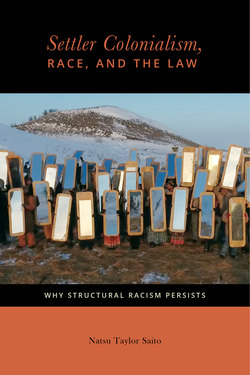Читать книгу Settler Colonialism, Race, and the Law - Natsu Taylor Saito - Страница 30
На сайте Литреса книга снята с продажи.
First Principles
ОглавлениеIn developing a narrative that frames racialization and racialized subjugation as a function of colonialism, I find it helpful to remain mindful of a few basic principles. The prime directive of settler colonization is to secure a territorial base, and this requires—from the settlers’ perspective—the elimination of those who, since time immemorial, have lived on, defined themselves in terms of, and taken responsibility for that land. Two central points emerge from this bedrock premise. The first is that settler societies, including the United States, cannot function as such without continuously enforcing their jurisdiction, political and military, over their claimed territories. This requires them to ensure that their assertion of sovereignty is accepted as legitimate within the larger global order, notwithstanding any illegalities involved in the acquisition or occupation of the lands at issue.99 The second point is that the decolonization of settler colonial states requires challenging their underlying territorial claims.100 Reforming settler societies to be kinder, gentler, more environmentally sustainable, or more inclusive legitimizes and, therefore, entrenches the underlying colonial relationships. Such reforms are incapable of dismantling settler hierarchies of power and privilege.
Moving from an analysis that focuses solely on the relationship between settlers and Indigenous peoples to a triangulated analysis that distinguishes migrants who are not intended to become part of the settler class from both settlers and Indigenous peoples runs the risk of glossing over the centrality of territorial occupation, thereby reinforcing settler hegemony.101 For this reason Kanaka Maoli (Native Hawaiian) scholar Haunani-Kay Trask insists that portraying immigrants to Hawai‘i as anything other than the functional equivalent of settlers means that “the history of our colonization becomes a twice-told tale” because it allows the political and economic “success” story of Asian immigrant laborers to reinforce a settler regime that keeps Indigenous Hawaiians landless and poor, lacking access to decent healthcare or education, institutionalized in the military, and disproportionately imprisoned.102 From this perspective, the status of Asians in Hawai‘i should be defined not in relation to White settlers but solely in terms of “their relationship to indigenous peoples in a settler state.”103
The same issues arise with respect to other non-Indigenous peoples of color throughout the United States. Stokely Carmichael articulated this very clearly with respect to those of African descent. Speaking in 1970 at Morehouse College in Atlanta, he identified the United States as a settler colony and explained in his typically straightforward manner:
In order to be a successful settler colony, one must commit genocide against the traditional owners of the land. This is exactly what the Europeans have done. . . .
When you call them Americans, you make it sound as if they belong here. You do that because you want to call yourselves black Americans and you want to feel that you belong here too. . . . [But] if we say we are Americans . . . it means that we participated in committing genocide against the red man and support the genocide that “Americans” are committing in Vietnam, Asia, Africa, and Latin America.104
Much as any of us may wish to “belong here,” if we are not indigenous to this land we would not be here but for settler occupation, and our relationship to structures of power and privilege must be understood in that context. Because our very presence as non-Indigenous peoples can legitimate settler society and its genocidal appropriation of Indigenous lands, struggles we wage to rectify the disparities between the settler class and non-Indigenous Others run the risk of rendering settler colonial institutions invisible while simultaneously reinforcing them.105 As Veracini explains, “The colonising settler can disappear behind the subaltern migrant” and settler states “can then be recoded as postcolonial migrant societies.”106
This danger must not be ignored or minimized. It need not, however, preclude development of accurate analyses of structural racism in the United States through particularized inquiries into the ways in which the settler class—defined as those who came with, and still live with, the presumption that this is their country—has facilitated the migration, voluntary or involuntary, of persons it never intended to fully incorporate into American society and developed a panoply of social institutions to ensure that non-settler migrants remain marginalized and subordinated. Such endeavors can help us understand the significance of the differences between the treatment of Indigenous peoples and the treatment of non-Indigenous Others, and how these distinctions are rooted in the diverse purposes served by various segments of the population over whom the settler class asserts hegemonic control.
The choice faced most immediately by non-Indigenous people in the United States is not necessarily “stay or leave,” but whether we are choosing to function as colonizers or to consciously pursue decolonization.107 The dominant narrative attempts to disappear Indigenous peoples and to convince the rest of us that we are simply part of a “nation of immigrants.” In that construction, the well-being of non-Indigenous people of color is enhanced by the consolidation of settler state hegemony. If, however, we understand the persistence of racialized injustices and disparities as reflective of the dynamic of difference essential to the maintenance of a colonial state, and accept that the subjugation of so-called racial minorities is rooted in the displacement of Indigenous peoples, we may see that Indigenous struggles for self-determination are, in fact, our struggles, too.
